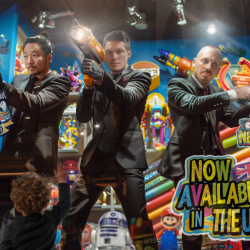The latest data from the British Retail Consortium (BRC) shows a pretty bleak outlook for the sector. Higher living costs are expected to continue to squeeze household budgets, resulting in a challenging year for shoppers and retailers. A key demonstration of this is Christmas (or the most important sales period of the year). To put it bluntly: it was less than festive. Across the UK retail sales increased by just 1.7% in December, significantly lower than the 6.9% seen the year before. Clearly, the ‘cautious consumer’ is a trend that isn’t abating, and particularly not in the first few months of 2024. In this environment retail brands must be at the top of their game, as several competitors selling similar products and services are lying in wait, ready to steal from their bottom line. This puts retail marketers under exceeding pressure to do more with less.
Brands want to tighten their belts but achieve the same results. They want to increase visibility, drive new business, and boost sales, all while reducing budgets and improving ROI. But is it possible to deliver better results while spending less? With a bit of know-how, undoubtedly, yes.
Here are three areas where brands can focus, to make sure every penny counts:
Don’t be a clickhead
For a long time our industry has considered clicks to be king. Many marketers see last-click attribution as an easy and accurate solution to measuring digital performance. There’s one problem: it’s not very effective at telling the whole story. It’s true, last clicks are valuable across the customer journey and deserve recognition. However, giving them all the credit is a narrow view of attribution that can hamper a brand’s ability to grow. For example, it’s not always true that the last piece of content a user saw led to conversion. In this mindset, a brand might overlook the other touchpoints that raise awareness and build trust. It’s imperative to consider interactions across the entire funnel.
So, if not clicks, what? Measuring ‘brand uplift’ provides a holistic assessment of the impact of campaigns on brands and sales. To put it simply, if you don’t know how campaigns affect your brand’s perception, building and growing long-term sales will be difficult. Right now, in such a competitive landscape, it’s easy to see why retailers might focus on short-term wins. However, as marketers, it’s up to us to ensure that the value of long-term activity is not overlooked. Without those top-of-the-funnel indicators, activity will stall, campaigns will flounder, and marketing effectiveness and efficiency will wane.
A balanced measurement framework is the key to understanding both the long- and short-term value your marketing activity is driving.
Embrace automation to drive efficiency
One of the biggest challenges marketers face is keeping up with change. This is where technology can help. Through the increased use of machine learning retail brands can create campaigns that stay ahead of the curve, delivering impressive results while keeping costs down. One strategy that can potentially change the game for marketers is Performance Max (PMAX), which can engage customers across Google’s entire ecosystem from a single campaign. Because it’s goal-driven, PMAX searches out audiences and placements to deliver on specific objectives. All marketers need to do is provide the creative assets, the headlines, descriptions and logos. Automation plays a big role, making real-time decisions about what ads customers see, where they see them and how much their click is worth.
Moreover, AI tools that can help retail do more with less are constantly being developed. Take our own PPC automation tool, N-Grams, which reduces keyword wastage — particularly for brands with larger keyword sets. Bold marketers leverage AI to drive profitable growth, generating sales, lowering costs and saving time. McKinsey found that 70% of companies that adopted AI saw a revenue increase, and 28% saw a reduction in expenses.
Marketers must be brave enough to stay ahead of the curve by testing these solutions. This will help them survive current challenges and thrive well into the future.
Why penny-pinch when you can money spin?
Doing more with less isn’t just about driving efficiency. Retail media networks allow brands to tap into new revenue streams using existing resources. Advertisers want to tap into retailers’ audiences and are willing to pay a premium to do it. From digital banners on a website to screens in stores, retailers can now exploit the full spectrum of their digital assets. This will generate new net revenue for their business.
As well as unlocking your customer base’s potential, retailers can tap into other brands via their own networks. Retail media networks are compelling because they’re so targeted. Used correctly, they enable you to personalise your content while gaining valuable insight into its performance. That means your budget won’t go to waste by showing your ads to people who couldn’t care less. Retail media is too big to fail. It’s no longer a secondary focus for retailers or brands — ad spend on retail media properties is expected to reach £6 billion in the UK this year. It’s too big an opportunity to pass up. Ultimately, this is a challenging time for retailers, but now is not the time to let up — it’s the time to double down. Driving efficiencies is a huge opportunity to improve processes, harness data, and enhance performance across the funnel.
If marketers can refocus and better balance short- and long-term objectives, retail brands can ride out the current crisis and thrive.
Featured image: Roman Pohorecki / Pexels


























